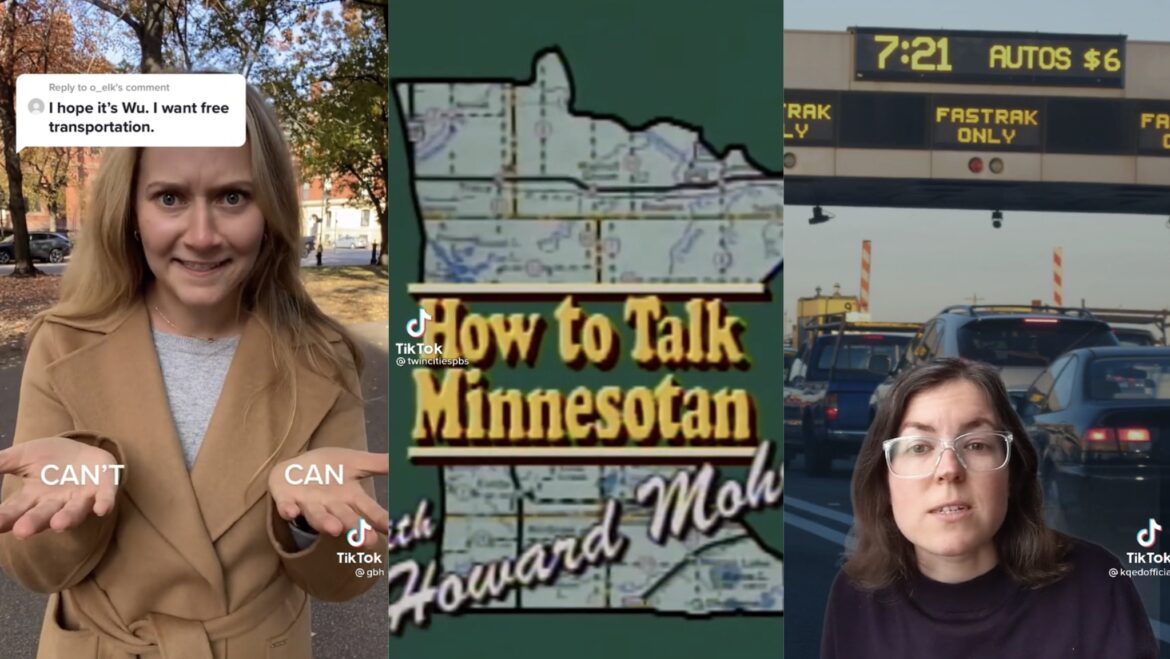More than just ‘the song and dance app’: Public media stations leverage new audiences on TikTok

Emily Schario in a GBH TikTok, a "How to Talk Minnesotan" TikTok from TPT, and Anna Vignet in a KQED video.
Amid the droves of young people dancing and lip-syncing to popular songs on TikTok, public media organizations are sharing local content on the app as they aim to reach audiences who may not be familiar with their traditional broadcast programming.
The popular app is a gateway to a large audience of younger viewers. TikTok announced in September that its users had surpassed 1 billion. A 2021 Pew Research Center survey found that people 18–29 years old used the app at a significantly higher rate than other age groups.
TikTok’s focus on short, typically silly videos has carved out a niche where public media can test approaches to sharing bite-size content. The platform seeded contributions from national public media producers such as Boston’s GBH, WNET’s Nature and NPR’s Planet Money in 2020 with Creative Learning Fund grants.
Since then, stations have also gotten into offering TikTok content with local appeal. Station producers post as many as several videos a week, drawing on contributions from colleagues throughout their organizations. Some are also resharing the videos on station Instagram accounts.
The aim is to engage viewers even if they may not become donors, said Anne Guttridge, an associate producer at TPT in St. Paul, Minn., who runs the station’s TikTok account.
“It has never really been a marketing thing for us,” Guttridge said. “We’ve really tried to focus on it as a tool for audience engagement and a tool to expand the kind of content we create … on different platforms.”
TPT’s TikTok account has drawn more than 33,000 followers since Guttridge started creating content about the 2020 election. After the election, she made a TikTok asking followers what content they wanted to see, which helped TPT’s account gain views and followers.
Guttridge started creating videos that focused on local arts and culture and drew on classic TPT content, like the show How to Talk Minnesotan. Seven TikToks based on the show have attracted more than 600,000 views. Another video in which Guttridge explains how Betty Crocker was a fictional person created in Minnesota for a marketing campaign has received over 1 million views.
Guttridge attributes the rapid growth of TPT’s audience to her efforts to tie into trends on the app. That increases the chances videos will appear on a TikTok user’s “For You” page, which is curated by an algorithm. In one video, Guttridge referenced a dance that was trending on the app at the time. It received more than 157,000 views.
“It’s cool to see people be surprised that we’re on the platform and that we are paying attention to trends and playing into things like story formatting and timing and how to caption things,” Guttridge said.
Creating content that sets you apart on the platform is key to success on TikTok, Guttridge said, as well as acknowledging that people engage with TikTok differently than they do with traditional media.
“The strategy is a bit more just having fun with it, letting it be a place where people can learn but also hopefully be entertained,” she said. “Because most, if not all, people are going to TikTok because they’re killing time. They want to learn something. They want to see something funny. They’re not sitting down in the same way that they would for an hourlong documentary, so we have to approach it differently.”
KQED: Reaching a younger audience and keeping it weird
Before Anna Vignet started making TikTok content for KQED, she found herself hooked on the platform. When KQED asked staffers for TikTok ideas, Vignet, a social video producer, jumped at the chance.
KQED has gained more than 17,000 followers on TikTok since it started producing content for the app in September 2020. Videos have covered science, cultural events, and news and public affairs. In one, Vignet outlined 10 California laws that went into effect at the start of 2022. Some of KQED’s TikToks have been in Spanish. The videos serve as standalone content while also complementing KQED’s radio and digital offerings.
By using TikTok, KQED aims to reach a younger audience that may not be tuning into the radio or reading articles on its website, Vignet said.
“The way we consume news is changing, and a lot of young people don’t drive, and that’s mainly where people listen to the radio,” she said. “And even though we are a radio station first, it’s becoming less of a way for people to find us. … A lot of younger people spend a lot more time on social media, so figuring out a way to get them journalism just creates a better society as a whole.”
KQED’s TikTok videos also help viewers understand more about the role of journalists. Vignet hopes to create more videos highlighting reporters’ day-to-day lives.
“One comment was like, ‘This girl in her house is from NPR?’” Vignet said. “So there’s a little bit of a dissonance about how someone in their house can also just be a reporter, because it’s not in the context of news that we traditionally understand. … News on TikTok is not something that people really associate with TikTok.”
Reluctance to see TikTok as a legitimate platform for news organizations may stem from a generation gap, Vignet said, with older journalists not understanding how popular the platform is with Gen Z.
“A lot of people see it as just like ‘that song and dance app,’ and they don’t take it seriously,” Vignet said. But ignoring its popularity “is counter to the goal of journalism,” she said.
Vignet said viewers have overall responded positively to KQED’s videos. As she creates more videos, she wants to include more KQED staffers, feature more departments and get “a little bit weirder” with it.
“Really focusing on the human aspect of TikTok is where I think public media, TV and radio stations, can find success, because that’s already kind of what happens on the radio,” she said. “… Someone is speaking in your ear. It’s a very intimate process.”
GBH: Being where the audience is
As Boston’s GBH has settled into the groove of TikTok, it has experimented with formats and ideas to see what sticks with audiences. It began on the platform with behind-the-scenes videos of life at the station, then produced science-based videos with its TikTok grant. Last fall, producer Emily Schario began producing and appearing in videos focused on Boston. The station’s Emerging Platforms team continues to create other TikTok content that draws from productions throughout the station.
In a video that has garnered more than 106,000 views, Schario runs up Heartbreak Hill, a part of the Boston Marathon course, while explaining its history and how it got its nickname. In other videos, she has biked around the city while talking about issues with bike lanes and broken down what the newly elected mayor of Boston can and can’t do.
“They all kind of circled around a very simple question: What is the history of Heartbreak Hill? What is the significance of the mayoral race? What can the mayor actually do?” Schario said. “Sometimes having a really simple question gives you a lot of space to be creative.”
News organizations interested in joining TikTok should consider how people spend their time and get news, said Tory Starr, GBH’s director of digital and social content innovation. TikTok has room for the types of journalism and storytelling that traditional media platforms are also known for, she said.
“We can be educational, and we can be smart and do good journalism … in a way that is relatable and sometimes funny, but sometimes just really interesting to watch,” Starr said. “Don’t take yourself too seriously on TikTok, and just extend the journalism that you know to a platform that is really prioritizing being interesting.”
Journalists shouldn’t see creating content for TikTok as an additional burden but a chance to grow and experiment with new things, Schario and Starr said.
“It’s not ‘What are we going to add to our plate?’” Starr said. “It’s ‘How are we going to shift in order to be where the audiences are?’”






